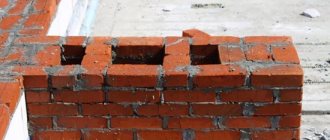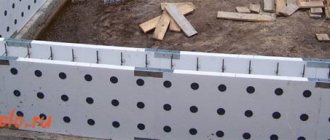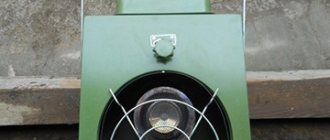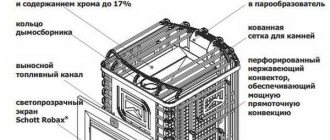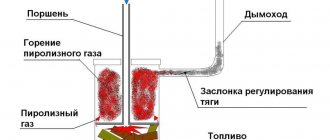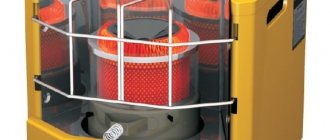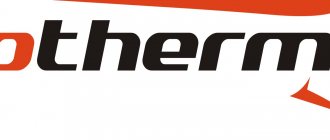Over time, used oil becomes less and less useful energy resource. But furnaces for waste garages are still quite popular today.
Garage owners especially benefit from such a heating system, because waste for homemade oil furnaces will not require expensive fuel.
The waste oil stove is simply designed, which allows you to build it yourself, thereby saving money.
Distinctive characteristics of structures during development
The operating principle of the stove is based on the thermal decomposition of fuel - pyrolysis. It uses the combustion heat of the waste, and this process is independently supported and regulated. But first, the fuel must be evaporated, and the vapors are heated to 300-400℃, then pyrolysis will begin to increase in the furnace.
In the lower section of the stove, heating and evaporation of the waste is carried out. Combustible vapors rise and, flowing through the pipe, interact with oxygen dissolved in the air.
In the upper section of the stove, the composition ignites and is burned in another section. When vapors burn, a significantly larger volume of heat is released and little smoke is produced.
The second method of dividing liquid into “easy-burning” elements is more effective , but more difficult to implement. For evaporation, a metal bowl is placed in the lower section of the oil furnace. It heats up, droplets falling on it are immediately converted into flammable vapors. The glow in the stove is beautiful, has a white-blue tint.
To achieve the greatest effect from fuel combustion, fuel is supplied to the lower section in very small doses: drops or a thin stream.
Types of stoves in production
All oil units are varieties of standard designs that operate according to the pyrolysis scheme:
- 2-chamber miracle furnace with an open-type afterburner.
- A drip furnace with a closed-type afterburner placed in the fuel chamber.
- Babington burner.
The burners are not easy to design, and it is better to use them in boilers connected to water heating.
A dropper stove is different in that the pipe is installed in the firebox and is designed to supply air mass for combustion.
Positive and negative qualities of various types of furnaces for mining
Regardless of the type of stove, they all have both positive and negative qualities. Let's take a closer look at them.
The advantages of such devices include:
- good heating of enclosed spaces, which include garages, greenhouses, and domestic buildings;
- energy independence (in case of installation of a naturally aspirated furnace);
- easy operation;
- small dimensions allowing the unit to be transported;
- cheap fuel;
- possibility of cooking;
- no open flame.
Drip-type primus in use - a handy thing in the garage
However, such stoves also have a lot of disadvantages:
- the need to filter used oil;
- the chimney, which requires frequent cleaning, must be at least 4 m;
- hot surfaces are very dangerous;
- specific smell of used oil;
- inability to extinguish the flame until the fuel completely burns out;
- fire hazard due to improper use;
- noticeable hum during operation.
If in the process of comparing advantages and disadvantages the first category is more significant, then such a unit is definitely suitable for the home craftsman.
The main danger of using such devices is ignition
Advantages and disadvantages
Pros of stoves:
- A substance is used that would otherwise be discarded.
- There are almost no toxic emissions into the air.
- Relatively simple oven design.
- Greater efficiency.
- Low cost of installing the stove and the fuel itself.
- The stove is safe to use, since the combustion area is reliably covered by an iron casing.
- Low fuel consumption: a stove with a water circuit will burn up to 1.5 liters. of fuel per hour to heat 100 square meters of area.
- The fuel supply and oven power can be adjusted.
- Easy to clean.
- Up to 10% of polluting substances in the waste composition is acceptable.
Disadvantages of the stove:
- If conditions are violated, fuel combustion is not complete. And the vapors enter the room.
- To ensure proper draft, the straightness and high height of the chimney is important - at least 5 m.
- Mandatory daily cleaning of the pipe and bowl.
- Before feeding fuel into an oil furnace, the bowl must be heated.
- You need to independently design water heating options - as an option, you can install a water circuit on the chimney.
- The difficulty of building a stove for a beginner.
- The flame constantly hits one area of the stove body, and therefore it burns out pretty quickly, unless it is made of stainless steel or thick metal.
Popular options for pre-fabricated furnaces, their characteristics
The Teplamos NT-612 stove is often chosen as a device used for heating a garage. The power of such a drip fanless heater can vary between 5-15 kW. Fuel consumption is 0.5-1.5 l/hour.
This furnace for use in a garage is a closed type device. It is equipped with a chimney, an air supply pipe and a built-in tank designed for 8 liters of fuel. Fuel combustion occurs in the inner chamber. The operation of the device begins with electrical heating of the plasma bowl. When the required temperature is reached, fuel is supplied and air is forced into the combustion chamber. The average cost of the device is 30 thousand rubles.
Note! For normal operation of the stove, it must be preheated with a small amount of diesel fuel, which is poured into a special bowl.
Another popular model is the Zhar-25 (MS-25) stove. This device can operate not only on waste oil, but also on diesel fuel. The device operates from the electrical network, which powers the internal fan. The thermal power of the furnace varies from 25 to 50 kW. It is designed to heat a room up to 500 square meters. m. Maximum fuel consumption is 4.5 l/hour. The device has large dimensions. Its weight reaches 130 kg. This stove needs to be equipped with a good chimney. You can buy it for 45 thousand rubles.
The exhaust furnace is equipped with a chimney, an air supply pipe and a built-in tank.
Constructing a dropper
To build a waste oil stove with your own hands, you usually use used gas cylinders.
It is advisable to use a “snail” from the interior heater of a VAZ 2108 as a blower fan, and a stainless steel pipe Ø 8-10 mm for the oil line.
To regulate the heating power, it is necessary to provide control of fan rotations and a mechanism for dosing the oil supply. Oil consumption can be monitored by eye. When fuel enters in drops in a jet rupture, it burns less than 1 l/h, and if a thin stream flows, more than 1 l/h.
It is better to control the operation of the fan using an inexpensive PWM controller.
After ignition and warming up, the best operating mode must be adjusted. It is important to achieve maximum transparency of the smoke from the chimney by drilling additional holes in the afterburner.
The best flame color is blue, normal is yellow, and red will indicate a low level of thermal output, high fuel consumption and soot formation in the furnace.
Required materials for assembling a furnace during mining
Before you make a stove using waste oil, you will need to prepare the necessary materials:
- Cylinder volume 50 l.
- Steel pipe (preferably Ø 10 cm). 2 m of product will be enough.
- Steel sheet. About 50 cm2 is needed for the bottom of the upper chamber and the plug. Steel thickness - 4 mm.
- Steel corner. You need a little more than a meter of 5-centimeter corner to make a stand for the stove, various components inside the heat exchange device and door handles.
- Brake disk. A car disc is used. You need to make sure that it passes easily into the cylinder.
- An empty freon cylinder with a working valve. You can use it to build an oil tank for the stove.
- A section of hose for supplying fuel.
- A pair of clamps.
- Part of a 1/2-inch pipe for conveying flammable materials.
- 0.5 inch valve.
- Loops.
Preparing the balloon
Old Ø 300 mm propane cylinders are often used. You need to unscrew the valve, fill the bottle with water and remove the top.
Advice: it is better not to use an oxygen cylinder due to the warm-up time. In addition, it may explode when cut.
Oil furnace body
- Cut holes for the chimney in the body and in the lid for installing the afterburner. Cut a control opening at the bottom of the cylinder, closing it with a bolted lid.
- Construct the afterburner pipe by drilling holes according to the drawing. Make 9 grooves at the bottom end of the pipe.
- Build a bowl out of steel (for example, from a car brake disc). Place it on the bottom of the firebox, raising it by 3-5 cm.
- Install the afterburner and put on the cylinder cap. Thread the oil wire into the pipe so that its end is located above the bowl.
- Make an oil tank with a fitting (for example, from a heating expansion tank) and hang it on the wall near the stove. Attach the chimney and calmly light the stove.
Oil supply system
Take a piece of pipe and weld it to the pan using the pre-made fuel fill hole. The pipe is first trimmed so that a stream of fuel can easily pass through the opening in the pan. We run the tube to the tank and install the valve.
To adjust the heating power, it is necessary to adjust the fan rotation control and the fuel dosage mechanism (for example, an automatic drinker with a jet break).
The waste oil flowing through the oil line falls into the bowl where it burns. For preheating, the fuel pipe is laid in the afterburner.
Heat exchanger
Mounted between the chimney pipe and the stove burner. An iron plate is welded to it. She holds the flame. This will also help distribute the fire inside the housing. And we put an air flow swirler inside it.
Use a piece of pipe Ø100 mm long such that its ends extend beyond the body by 10-20 cm on both sides. 2 holes are made in the body on opposite sides, into which a pipe is passed, secured by welding.
It is better to equip the unit with air injection using a duct fan, as shown in the diagram. It is installed on one side of the heat exchanger. You can connect a thermal relay to it. This will make it possible to independently record the temperature and lead to resource savings.
If there are water batteries, it is possible to connect 4-5 coils in parallel through the upper chamber. Then the design is supplemented with a circulation pump and a fan device.
A stove with a water circuit using waste oil will heat an entire house, but in order for it to be safe, you need to allocate a room for it.
Note. A potbelly stove can also operate using natural draft, but then you need to increase the diameter and number of holes in the afterburner.
Doors and shut-off valves
The doors are pre-cut in the body. An opening is also cut in the door of the lower chamber, this is done to allow free flow of air to the pan and burner. The opening in the upper door must be equipped with plates for additional sealing.
A regular lock is assembled for the top door. When heated, the body moves. To ensure that the combustion chamber is still airtight, the top door must be locked extremely securely.
Smoke pipe and chimney
The chimney is made from a pipe Ø 10 cm. It is welded at the hole to the center of the top of the body. The chimney is led outside to the roof through the wall. It is advisable to pass the pipe in a special fire-resistant glass.
Ignition and stop of the furnace
- First, pour waste oil into the pan. There is enough oil even if it only covers the bottom of the pan.
- We take a piece of foam rubber, which we carefully moisten with solvent or gasoline. Then it is placed in the oven tray so that the bottom of the piece is immersed in the oil.
- The foam rubber is set on fire. It burns steadily even when the draft is excessive. Thanks to this, the pan will warm up to the required temperature.
- Carefully open the valve of the waste oil tank so that it flows in a thin stream. Feed adjustment should be done as slowly and carefully as possible.
- The oven will soon enter operating mode. Monitor the volume of fuel in the pan.
- To stop the heating furnace during production, close the valve on the oil tank, and when the fuel stops flowing, you will need to close the additional valve. The oil stove will go out in 3-5 minutes. and the body will gradually cool down.
Safety precautions when using waste oil stoves
- Installation is only possible in rooms where there is a ventilation system.
- When working with a furnace during mining, it is necessary to comply with fire safety requirements and prepare the fuel - settling and filtering.
- It is possible to introduce an automatic safety system into the IV.
- Experts do not recommend making a non-drip stove or a stove with an uncovered burner and flame.
Furnace in production: options for making the device yourself
With the approach of cold weather, many craftsmen are coming up with various designs for heating the room and heating water. First of all, the question is about the type of fuel. In search of the most rational and cheapest option, many choose to work off, the average consumption of which is about 2 liters per hour. A waste oil furnace has a number of advantages. Knowing all the intricacies of its manufacture, you can create a budget-friendly and efficient source of heat in the house.
Garage stove: photo examples, varieties, how to make it yourself (read more)
Creating a homemade stove for mining is not a labor-intensive process.

